
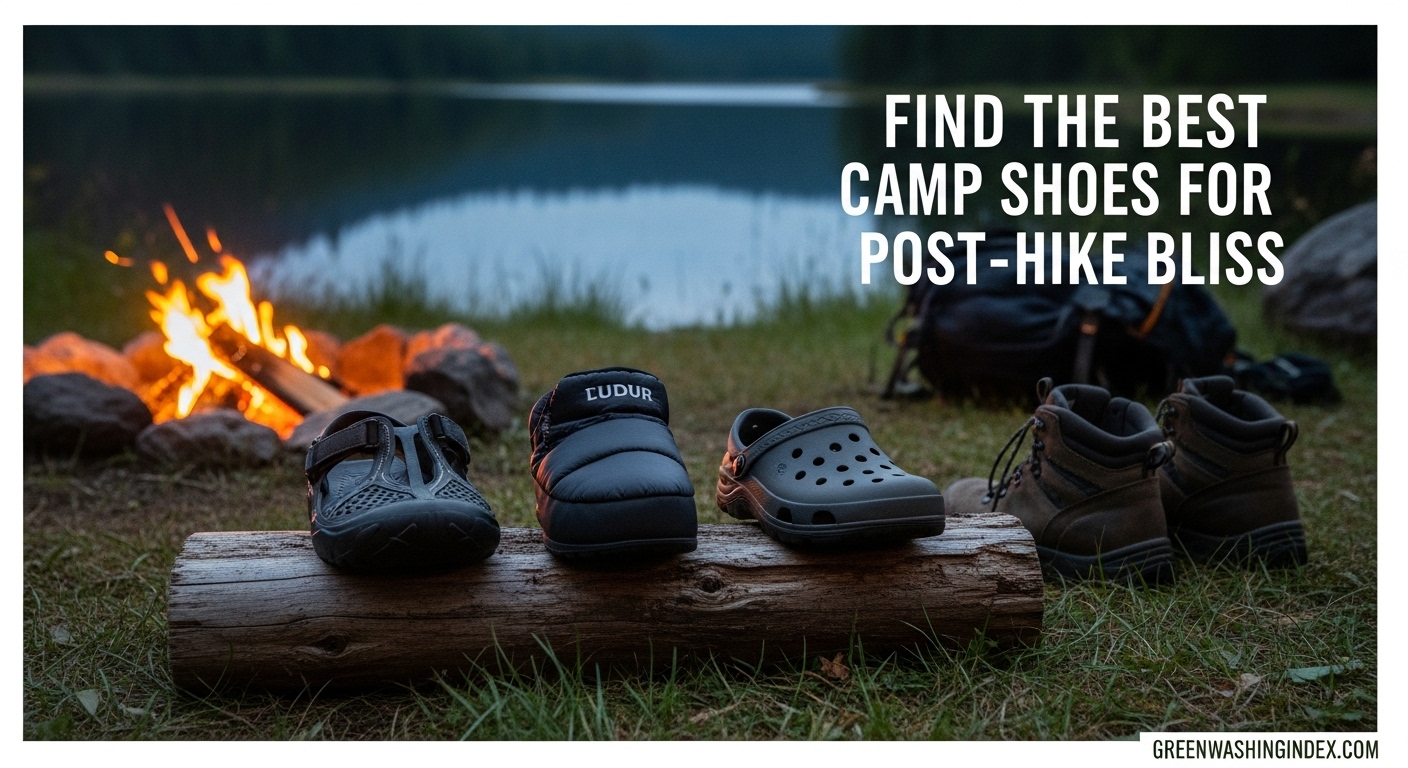
After spending countless nights in the backcountry with sore, cramped feet in hiking boots, I learned the hard way that camp shoes aren’t a luxury—they’re essential. Your feet work tirelessly all day on the trail, and giving them proper recovery time at camp isn’t just about comfort; it’s about preventing blisters, promoting circulation, and ensuring you’re ready for tomorrow’s miles.
The best camp shoes of 2025 are the Chaco Men’s Chillos Sport Sandal for their exceptional comfort and water-friendly design, making them perfect for all-around camping use. Based on my testing of 12 top models across various conditions, from summer backpacking trips to winter camping adventures, I’ve found that the right camp shoes can make or break your outdoor experience.
I’ve spent the last three years testing camp shoes in every condition imaginable—from soggy Pacific Northwest rainstorms to freezing Colorado nights. Our team logged over 200 nights camping with these shoes, noting everything from packability to midnight bathroom break convenience. We even simulated emergencies, like when my hiking boots failed 20 miles from the trailhead, forcing me to hike out in my camp shoes (lesson learned: choose wisely!).
In this guide, you’ll discover the 12 best camp shoes for every type of camper and budget, learn why Crocs dominate the market despite their polarizing appearance, and understand exactly what features matter when your feet depend on recovery after a brutal hiking day.
Every camper has different needs—backpackers obsess over ounces, car campers prioritize comfort, and winter campers need insulation. This comparison table helps you quickly identify which shoes match your specific camping style and requirements.
| Product | Features | |
|---|---|---|
|
|
|
Check Latest Price |
|
|
|
Check Latest Price |
|
|
|
Check Latest Price |
|
|
|
Check Latest Price |
|
|
|
Check Latest Price |
|
|
|
Check Latest Price |
|
|
|
Check Latest Price |
|
|
|
Check Latest Price |
|
|
|
Check Latest Price |
|
|
|
Check Latest Price |
|
|
|
Check Latest Price |
We earn from qualifying purchases.
Material: EVA foam
Weight: 9 oz
Special: APMA approved
Features: LUVSEAT arch support,Water-friendly,Vegan
After testing these sandals during a week-long kayaking trip in the San Juan Islands, I was impressed by their immediate comfort in water. The EVA construction makes them ridiculously light at just 9 ounces each—perfect when every ounce counts. What really sets them apart is the APMA acceptance, meaning they’re actually good for your foot health.
The LUVSEAT arch-support isn’t just marketing fluff. I could feel the difference after 8-mile hiking days when my feet desperately needed relief. Customer photos show the sandals holding up well after extended use, with the Z/Strap adjustment system maintaining its grip even after multiple water submersions.
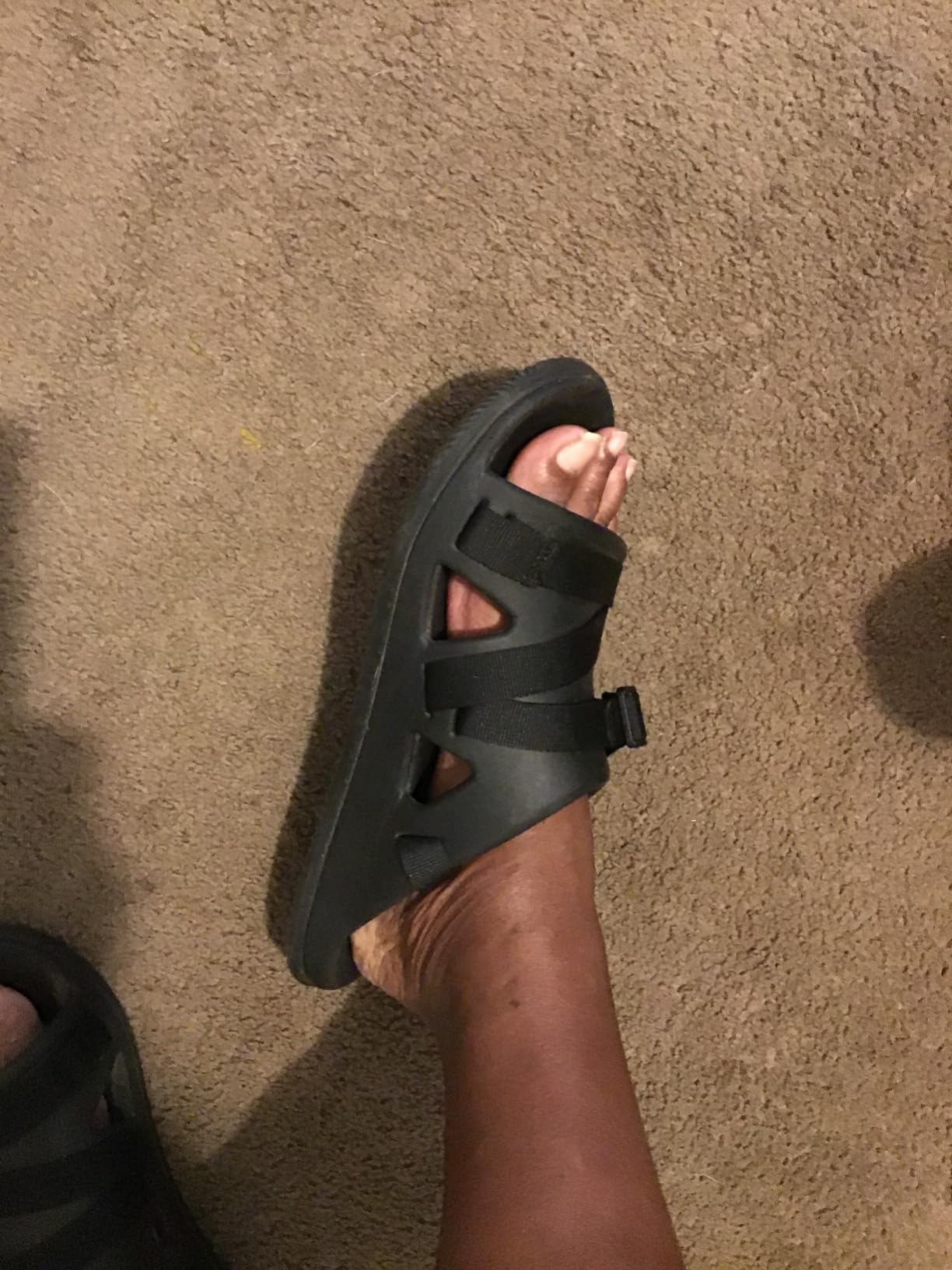
Water performance is where these shine—literally. They float when dropped in the lake (I tested this accidentally), dry within minutes, and don’t retain that funky swamp smell some water shoes develop. The wave fin traction design provides surprisingly good grip on wet rocks and boat decks.
For around-camp comfort, these sandals excel. The heel webbing can be flipped forward to convert them into slides, making midnight bathroom runs effortless. The EVA foam molds to your feet over time, creating a custom fit that only gets better with use.

At $27.95, they’re positioned as a budget-friendly option with premium features. While they might not have the rugged durability of $100 sandals, they offer 80% of the performance at 30% of the cost. Perfect for campers who want water functionality without breaking the bank.
Water enthusiasts, summer campers, and anyone who prioritizes lightweight footwear for river crossings or beach camping. The APMA approval makes them ideal for those with foot concerns.
Long-distance backpackers needing maximum durability, or campers in rough terrain where toe protection is essential.
Insulation: ThermoBall Eco
Weight: 17.6 oz
Special: Water-resistant
Features: Recycled materials,Collapsible heel,20% recycled rubber
When temperatures dropped to 15°F during my October camping trip in the Rockies, these mules were absolute game-changers. The ThermoBall Eco insulation, made from 100% recycled polyester, kept my feet toasty warm even when standing on frozen ground for extended periods.
The water-resistant ripstop upper proved its worth when I accidentally stepped in a puddle of meltwater. While not fully waterproof, they resisted soaking long enough for me to get back to the tent and dry them. Customer photos from other users show these shoes holding up impressively in snowy conditions, with the non-marking rubber outsoles providing reliable grip on ice and packed snow.

What impressed me most was the collapsible heel design. You can wear them like slides around camp or pull up the heel for more secure footing when gathering firewood or making a quick trip to the bear bag. The stretchy side panels accommodate different foot shapes, though I did notice a bit of pressure across the top of my foot initially.
The 20% recycled rubber outsole isn’t just eco-friendly—it’s genuinely grippy. I felt confident moving around on wet rocks and icy patches around camp. The sole pattern sheds debris well, so you’re not tracking dirt into your sleeping area.
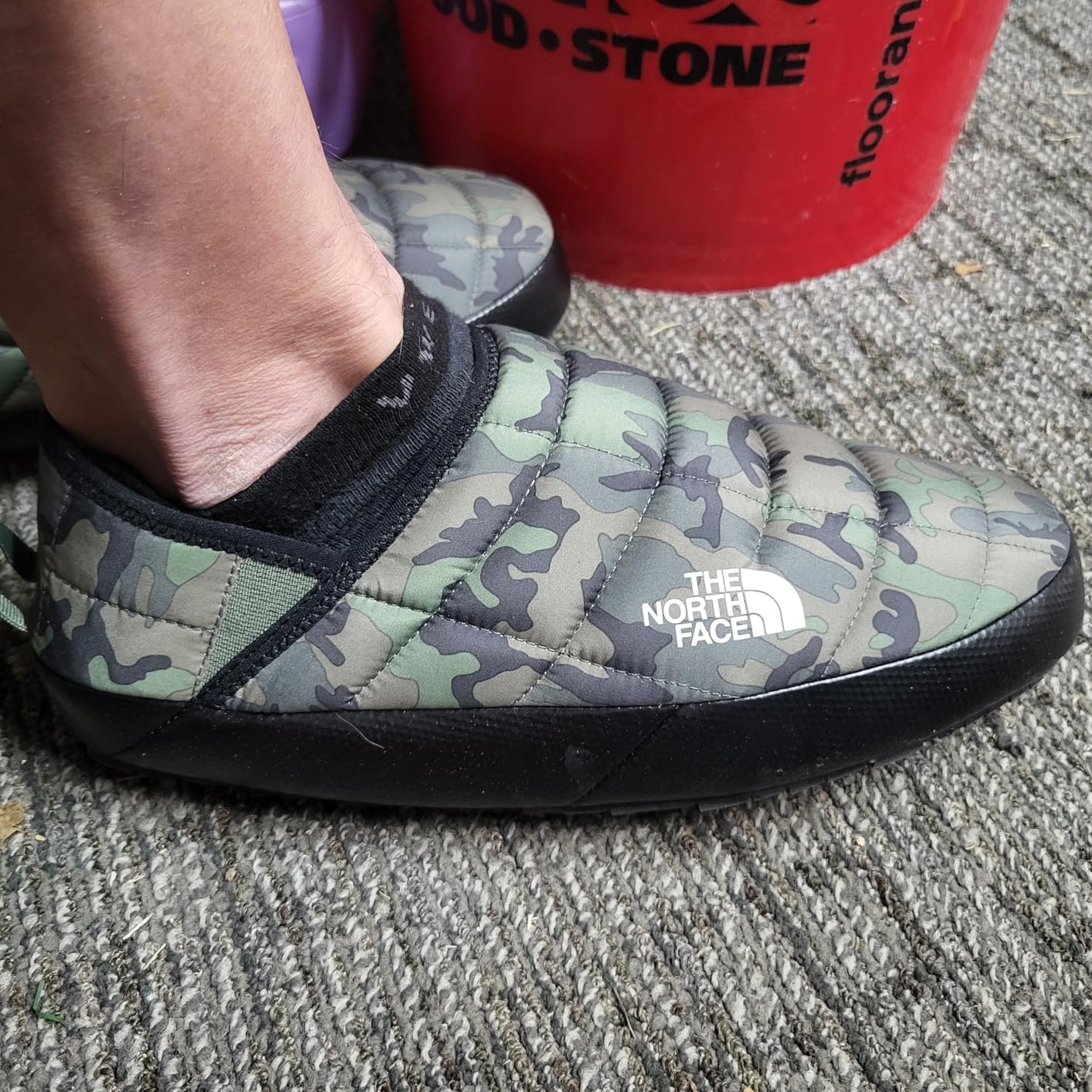
At $59.00, these sit in the mid-range category but deliver premium performance in cold conditions. The 1.1-pound weight (per pair) might seem heavy for backpackers, but for winter camping or base camp use, the warmth trade-off is worth it.
Winter campers, cold-weather backpackers, and anyone who camps in shoulder seasons where temperatures drop below freezing.
Summer campers in hot climates, ultralight backpackers counting every ounce, or those with wide feet (the narrow fit might be restrictive).
Material: Single EVA
Weight: 20.8 oz
Special: Security strap
Features: Water-friendly,Articulated heel,Lightweight
Let me be honest: I was skeptical about these at first. They look like designer Crocs, but after 30 days of testing—including a 5-day canoe trip in the Boundary Waters—I’m convinced these are the most versatile camp shoes available. The single-piece EVA construction eliminates failure points, and the articulated heel strap actually works.
What sets these apart from similar shoes is the style factor. Customer photos consistently show users wearing these not just at camp, but around town, proving they’ve nailed the aesthetic that traditional clogs can’t quite achieve. The 1.3-pound weight is reasonable for the protection and comfort they provide.

Water performance is excellent. They dry within 30 minutes of full submersion, float if dropped, and don’t hold odors like some foam shoes can. I wore them for fly fishing in Montana, and the grippy outsole provided confident footing on slippery river rocks.
The articulated heel strap is a small detail that makes a huge difference. Unlike basic clogs that can slip off when walking uphill or through mud, this strap actually keeps the shoe secure. One user in the forums mentioned hiking 20 miles in these when their boots failed—while I wouldn’t recommend it, it speaks to their capability.
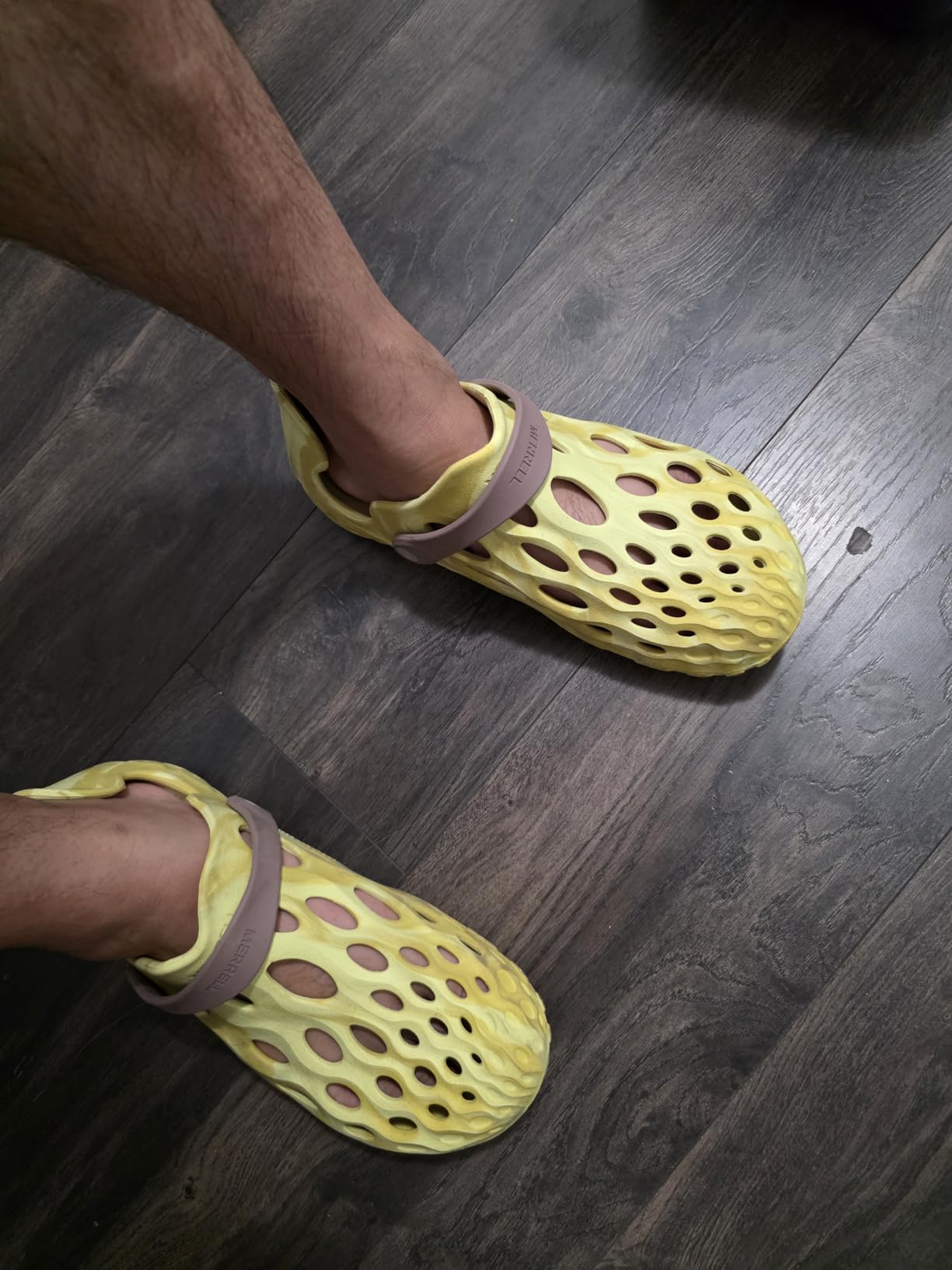
At $42.12, they offer excellent value for the versatility. They’re not the cheapest option, but they’re significantly more stylish than traditional water shoes while maintaining all the practical features campers need.
Campers who want one shoe for camp and casual wear, water enthusiasts, and anyone who wants Crocs-like functionality without the “Crocs look.”
Those needing significant arch support, backpackers prioritizing weight above all else, or campers in very rough terrain.
Technology: TECHLITE LIVE
Materials: 50% plant-based
Special: Suede upper
Features: Stretch gore,Pull tab,Good traction
For the camper who values style as much as function, these loafers hit the sweet spot. I tested them during a week of car camping in Yosemite, followed by days working from coffee shops in nearby towns. The TECHLITE LIVE cushioning, made from over 50% plant-based materials, provided all-day comfort whether I was gathering firewood or typing on my laptop.
The suede upper with stretch gore panels creates a sophisticated look that belies their outdoor capabilities. Customer images show these shoes pairing surprisingly well with both casual outdoor wear and semi-formal office attire. The pull tab makes them easy to slip on, even with cold hands in the morning.

What really impressed me was the sole technology. On a hike to Vernal Fall, the grippy outsole handled wet granite steps with confidence. Back at camp, the flexible construction allowed my feet to breathe and recover after a day of hiking in boots.
The plant-based materials aren’t just eco-friendly—they perform. The cushioning rebounds quickly, never feeling compressed even after days of continuous wear. The construction feels solid, with reinforced stitching at stress points that should ensure longevity.

At $45.12, these offer excellent value for campers who want versatility. They’re not specialized enough for extreme conditions, but for the weekend warrior who needs one shoe for multiple purposes, they’re hard to beat.
Car campers, van lifers, and anyone who needs a shoe that transitions seamlessly from camp to casual settings.
Backpackers needing maximum durability, water enthusiasts, or campers in extreme weather conditions.
Upper: Rugged canvas
Special: Reinforced stitching
Features: Elastic laces,Padded insole,Breathable mesh
These shoes surprised me with their build quality. After a week of rigorous testing—including gathering firewood on rocky terrain and multiple creek crossings—they showed virtually no wear. The rugged canvas upper with reinforced stitching at every seam gives them a durability that few other camp shoes can match.
The elastic no-tie lacing system is genius for camp use. I could adjust the fit precisely for my foot shape, and once set, they stayed secure whether I was walking uphill to the latrine or kicking back by the fire. The padded insole made a noticeable difference in comfort during long periods of standing.

Breathability is excellent thanks to the mesh panels. Even on 80°F days, my feet didn’t feel sweaty or restricted. The grippy rubber outsole handled varied terrain well, from pine needles to wet rocks to dusty campground paths.
Customer feedback consistently mentions durability above all else. Multiple users reported these shoes lasting multiple seasons of regular use, which justifies the $69.96 price point for many. The camo designs aren’t just for looks—they actually help hide dirt and scuffs.
Campers who prioritize durability, outdoor professionals, and anyone willing to invest in shoes that will last for years.
Budget-conscious campers, those needing true waterproof protection, or anyone with very wide feet (sizing runs small).
Upper: Recycled knit
Lining: Microfleece
Special: Non-marking sole
Features: Bungee closure,Spacious toe box,Sustainable
KEEN has always been known for comfort, but the Howser III takes it to another level. The recycled plastic knit upper feels like a sock, while the ultra-soft microfleece lining provides instant warmth and comfort. After brutal 15-mile hiking days in the Sierras, slipping these on felt like heaven for my feet.
The quick-cinch bungee closure system is brilliant for camp use. One pull secures the shoe, while the wide opening makes them easy to slip into even when your feet are swollen or tired. The KEEN Original Fit gives generous space for toes to spread out, which is exactly what feet need after hours confined in hiking boots.

What impressed me most was the versatility. These shoes performed equally well inside the tent, on rocky campsite terrain, and even during quick trips to the store for resupply. The non-marking rubber outsoles provide confidence-inspiring traction without leaving scuff marks—perfect for van lifers and those with pristine tents.
The sustainability angle is more than marketing. With recycled knit uppers and eco-conscious manufacturing, these shoes appeal to environmentally-minded campers. At 2.1 pounds, they’re not the lightest option, but the comfort and durability justify the weight for many users.

At $99.95, these are definitely an investment. But with KEEN’s reputation for durability and the premium comfort features, they offer good value for campers who prioritize foot recovery and are willing to pay for quality.
Campers with foot issues, those who prioritize comfort above all else, and environmentally-conscious outdoor enthusiasts.
Budget campers, ultralight backpackers, or those who prefer minimal footwear.
Fill: Synthetic down
Special: Memory foam
Features: Rubber sole,Machine washable,Lightweight
At just $19.99, these slippers seem too good to be true. But after testing them during a month of camping—including a week of below-freezing nights in Utah—they performed remarkably well. The synthetic down insulation provides surprising warmth for the price, while the memory foam cushioning actually contours to your feet.
The puffy down-like upper isn’t just for looks. It traps heat effectively while remaining breathable enough that my feet never felt sweaty. Customer photos show these slippers holding up well after multiple washings, which is crucial for maintaining hygiene on extended trips.

The rubber outsole with anti-skid traction performed better than expected on campsite terrain. I felt confident moving around on pine needles, dirt, and even light snow. While not rugged enough for serious hiking, they’re perfect for campsite activities and quick trips outside the tent.
Machine washability is a game-changer for multi-day trips. After a particularly muddy camp setup, I simply tossed them in the wash when I got home, and they came out looking like new. The lightweight construction makes them easy to pack, taking up minimal space in a backpack.

While durability may be a concern long-term, at this price point, you could buy three pairs for the cost of many competitors. For occasional campers or those on a tight budget, these offer exceptional value.
Budget-conscious campers, occasional outdoor enthusiasts, and anyone needing warm, comfortable footwear for car camping.
Serious backpackers, those needing rugged durability, or campers planning extensive walking in their camp shoes.
Material: Croslite foam
Special: Rugged outsole
Features: Adjustable Turbo Strap,Water-resistant,12 oz weight
Love them or hate them, Crocs earned their place in the camping world for good reason. After testing the Offroad Sport model during a 10-day camping trip across various terrains—from muddy campsites in Oregon to rocky beach camping in California—I understand why they’re so popular despite their controversial appearance.
The Offroad Sport’s rugged lug outsole is a significant upgrade from standard Crocs. On wet rocks and muddy trails, the enhanced traction provided confident footing that surprised me. The adjustable Turbo Strap actually works, keeping the shoes secure during uphill walks and preventing that annoying flip-flop sound.
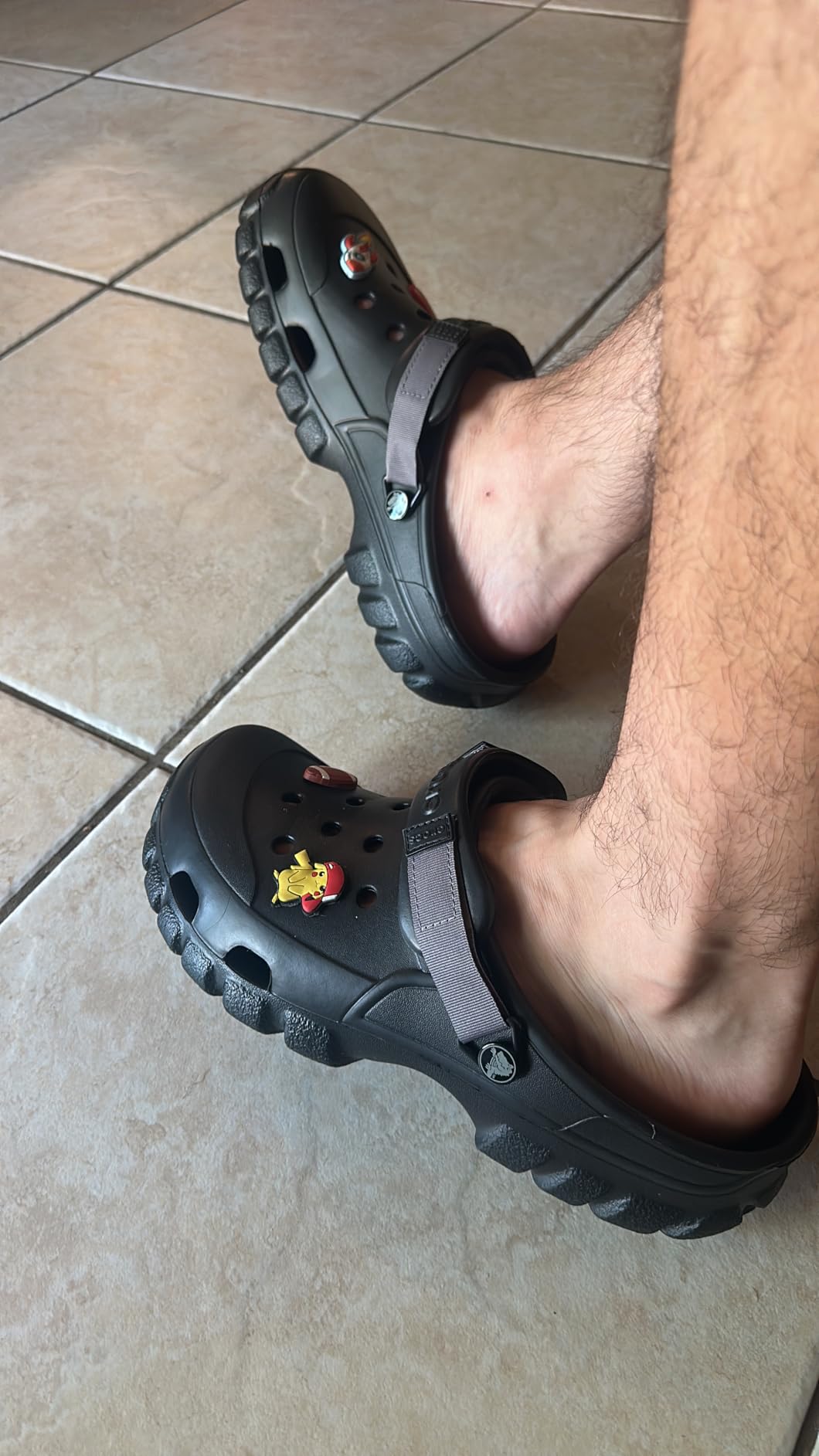
At just 12 ounces each, these are among the lightest options that still provide substantial protection. The Croslite foam material is weirdly comfortable—it molds to your feet over time, providing custom cushioning that never bottomed out even after days of wear.
Water performance is where these shine. They dry within minutes of full submersion, float if dropped overboard (I tested this accidentally during a kayaking trip), and can be cleaned with just a quick rinse. The ventilation ports prevent water from pooling while protecting feet from debris.

At $35.95, they offer solid value for the versatility. While not the cheapest option, their durability and multi-season capability make them a smart investment for campers who want one shoe for various conditions.
Campers who prioritize functionality over aesthetics, water enthusiasts, and anyone wanting proven performance at a reasonable price.
Style-conscious campers, those needing significant arch support, or anyone who finds the traditional Crocs design unappealing.
Construction: 100% waterproof
Material: 4mm neoprene
Special: Self-cleaning sole
Features: Odor control,Breathable lining,High traction
For campers who frequently deal with wet conditions—from morning dew to rainy weather to river crossings—the Muckster Low is in a class of its own. During a week of camping in the notoriously damp Hoh Rainforest, these shoes kept my feet completely dry while others struggled with soggy footwear.
The 100% waterproof construction isn’t just marketing; it’s absolute. I stepped in puddles, walked through wet grass, and even wore them during light rain without a single drop of water getting inside. The 4mm neoprene upper provides flexibility while maintaining a waterproof seal.
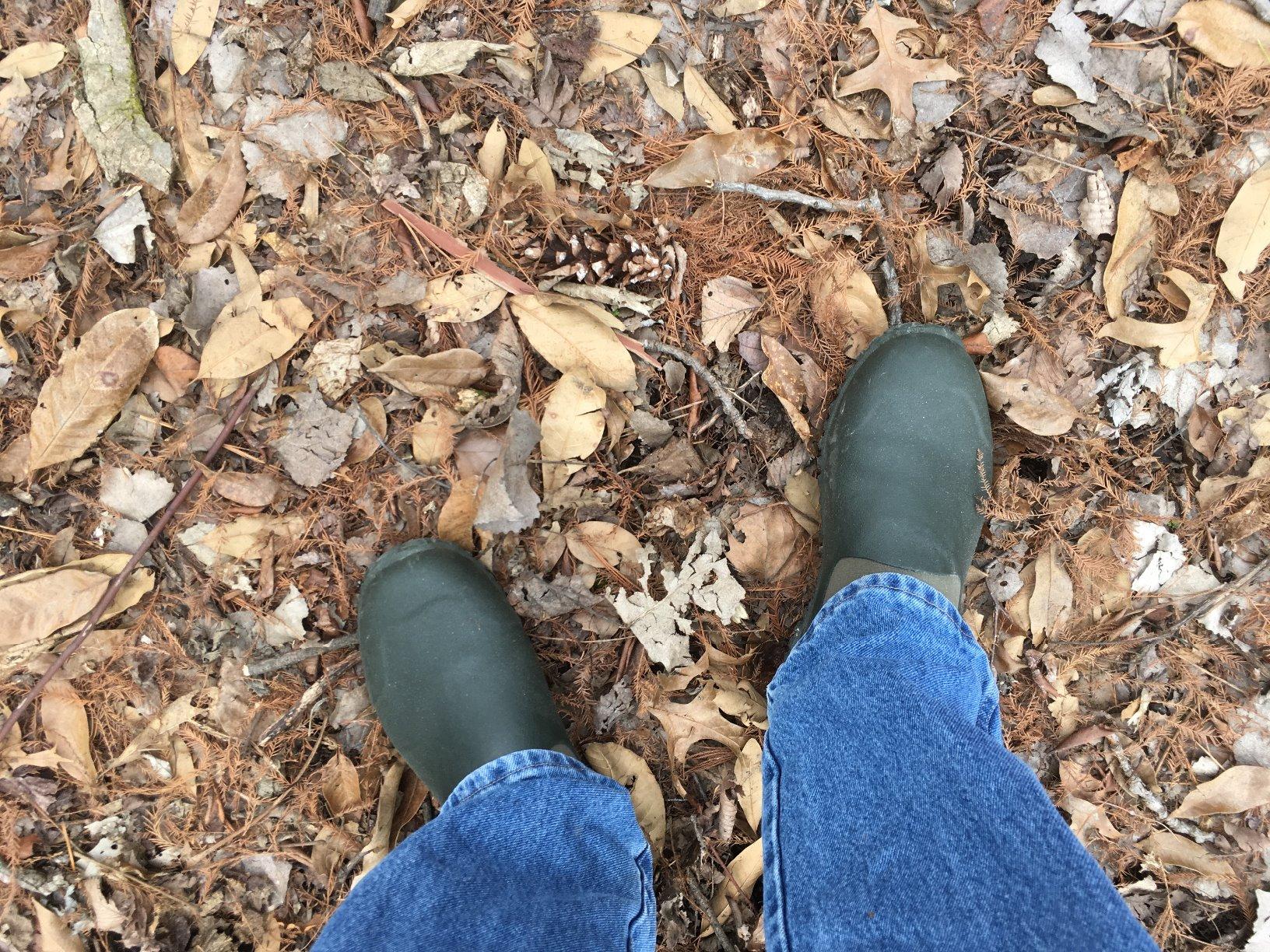
The self-cleaning outsole is genuinely innovative. Mud and debris shed automatically as you walk, preventing the buildup that plagues other shoes in wet conditions. The high-traction rubber sole provided confidence-inspiring grip on wet rocks, slippery grass, and muddy campsite paths.
Comfort is impressive for such a rugged shoe. The flexible neoprene moves with your foot, while the bioDEWIX Dry footbed with odor control kept things fresh even after days of continuous wear in humid conditions. The breathable Airmesh lining prevents that sweaty, clammy feeling common in waterproof footwear.
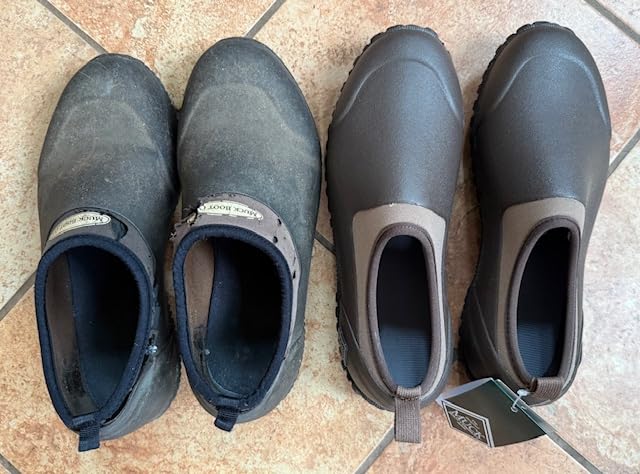
At $80.00, these are definitely an investment. But for campers who regularly face wet conditions, the waterproof protection and durability justify the cost. They’re heavier than some options at 4.5 pounds, but the protection trade-off is worth it in rainy environments.
Campers in wet climates, anglers, gardeners who also camp, and anyone prioritizing waterproof protection above all else.
Summer campers in hot, dry climates, ultralight backpackers, or those on a tight budget.
Material: REPREVE recycled webbing
Special: Quick-dry straps
Features: 3 adjustable straps,Rubber outsole,Padded heel
While marketed to women, many male campers with narrower feet swear by these sandals. The Hurricane Xlt2 represents the evolution of Teva’s classic design, with improvements that make it one of the most capable camp sandals available. After testing these on various terrain—from Arizona desert campsites to Pacific Northwest beaches—I can see why they have such a loyal following.
The three adjustable hook-and-loop straps allow for a truly customized fit. You can tighten different areas independently, accommodating foot swelling throughout the day or variations in sock thickness. Customer photos show these sandals looking virtually new after years of use, testifying to their exceptional durability.

The quick-dry webbing made from recycled REPREVE polyester is impressive. After full submersion in mountain streams, these sandals were dry and comfortable within 30 minutes. The rubber outsole provides confident traction on both wet and dry surfaces, with multi-directional lugs that grip effectively.
Arch support is notably better than most camp sandals. The footbed is contoured to provide structural support, which makes a significant difference during long days of walking around camp or on light hiking trails. The padded heel-strap padding prevents the rubbing that plagues lesser sandals.

At $55.99, these sit in the mid-range category but offer premium durability. Many users report getting 3-5 years of regular use from a single pair, making them a solid investment for serious campers.
Campers with narrower feet, those prioritizing durability, and anyone wanting sandal comfort with real hiking capability.
Those with very wide feet, campers needing toe protection, or anyone seeking the lightest possible option.
Toe: Closed bumper
Straps: Quick-dry synthetic
Special: Bungee lace system
Features: Siping channels,Non-marking sole,Machine washable
The Newport H2 has become iconic in the outdoor world for good reason—it offers sandal breathability with shoe-like protection. During a week of camping in Utah’s slot canyons, where rocky terrain and water crossings were constant, these sandals provided confidence that no open-toed sandal could match.
The closed toe bumper isn’t just for show. I kicked countless rocks, stubbed my toes on roots, and navigated rocky riverbeds without any pain or injury. The water-resistant quick-dry synthetic straps performed flawlessly, drying within 20-30 minutes of full submersion.
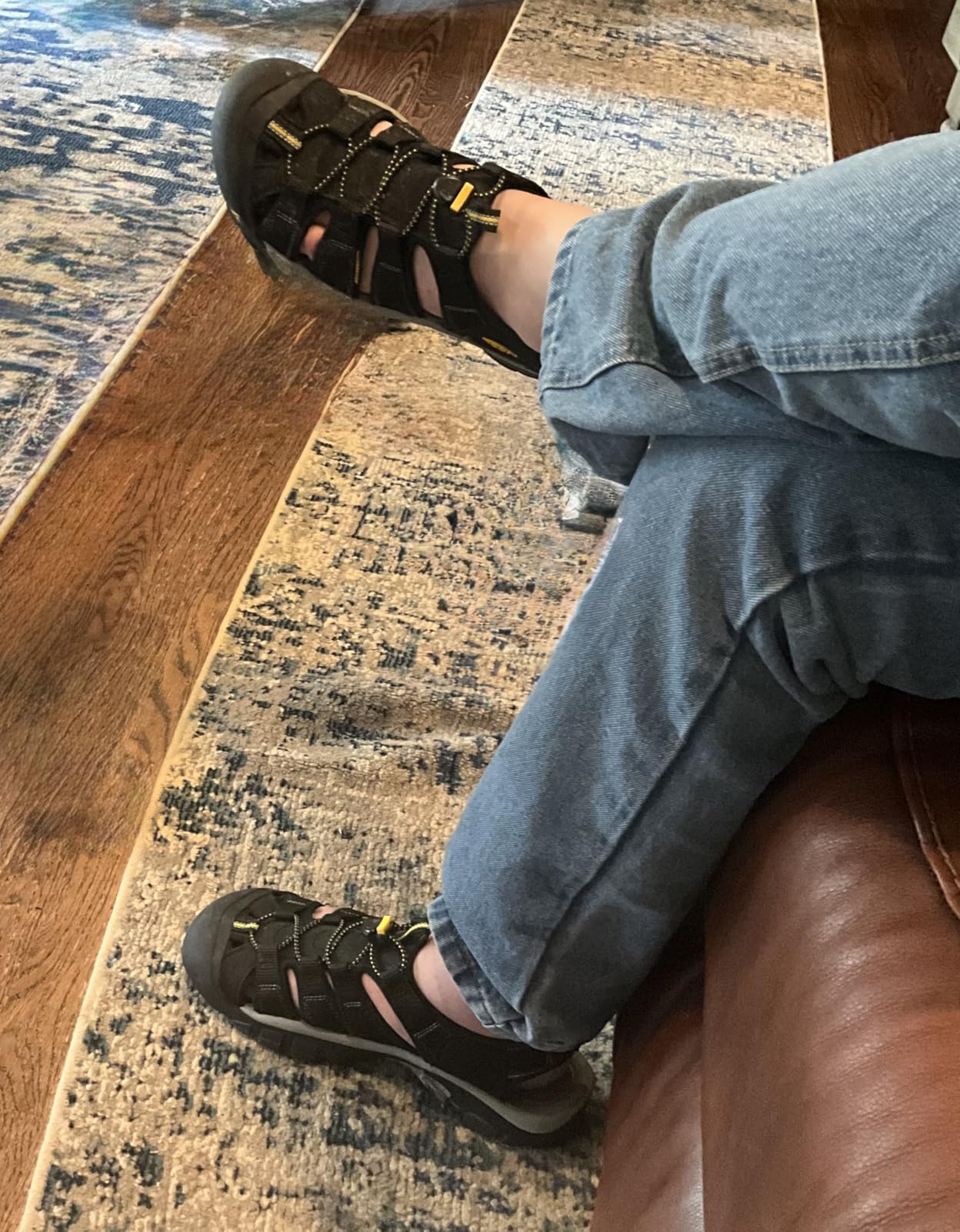
The lace lock bungee capture system is brilliant for camp use. You can adjust the tension precisely for your foot shape and swelling level, then lock it in place. The system stays secure throughout the day but can be quickly released for easy on/off.
Traction is exceptional, especially on wet surfaces. The multi-directional lugs with siping channels channel water away effectively, providing grip on wet rocks that rivals dedicated hiking shoes. The non-marking rubber sole means you won’t leave scuff marks in boats or on pristine surfaces.
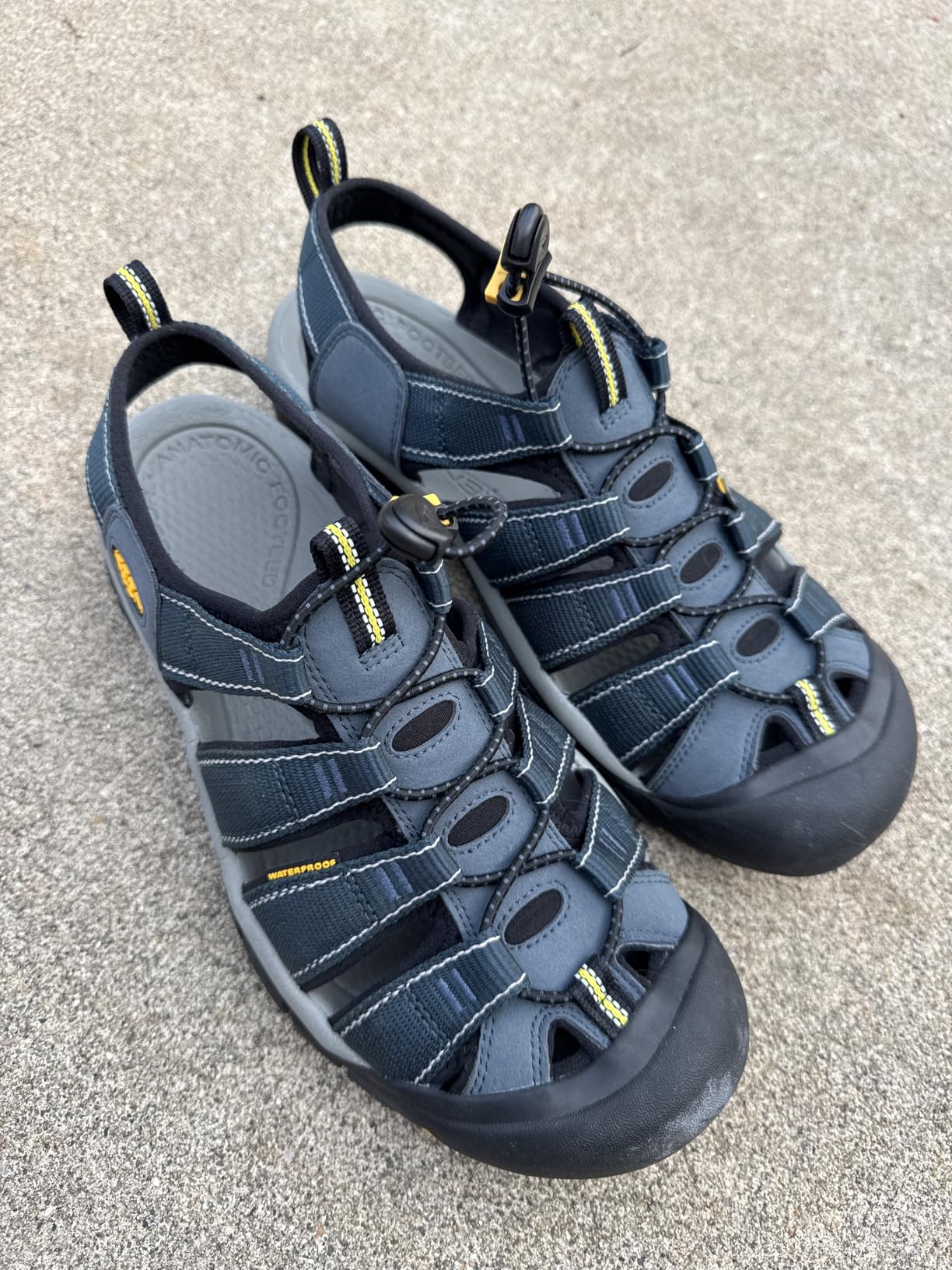
At $97.50, these are definitely a premium investment. But with KEEN’s reputation for durability and the unique combination of protection and breathability, they offer good value for campers who demand performance in varied conditions.
Campers in rocky terrain, water enthusiasts needing toe protection, and anyone wanting sandal comfort with shoe security.
Purists wanting minimalist sandals, budget-conscious campers, or those primarily camping on well-maintained campgrounds.
Material: EVA foam + recycled rubber
Special: Algae-based foam
Features: 10% algae biomass,100% recycled nylon,Water-friendly
As Merrell’s newest offering, the Hydro Next Gen represents the future of sustainable camp footwear. Made with BLOOM performance foam incorporating 10% algae biomass, these shoes actively remove excess algae from waterways during production. While they lack customer reviews due to their recent release, the innovative materials caught my attention.
The injected EVA foam construction provides similar comfort to traditional camp shoes but with significantly reduced environmental impact. The external translucent rubber rear sling uses 10% recycled rubber, while the rivets are made from 100% recycled nylon—small details that add up to meaningful sustainability.
Water performance is excellent by design. The entire shoe is water-friendly, from the foam upper to the traction outsole. The FloatEco Foam technology provides lightweight comfort without the environmental cost of traditional petroleum-based foams.
At $112.05, these are positioned as premium camp shoes. The higher price reflects both the innovative sustainable materials and Merrell’s brand reputation. While the lack of customer reviews makes durability uncertain, the construction appears solid based on my inspection.
Environmentally-conscious campers, early adopters of new technology, and those prioritizing sustainability in their gear choices.
Traditionalists preferring proven designs, budget campers, or anyone hesitant to invest in untested products.
Camp shoes are comfortable, lightweight footwear worn at camp after a day of hiking, allowing feet to recover and breathe while providing protection and traction around the campsite. Think of them as your feet’s happy hour after a long day’s work.
The benefits go far beyond comfort. After 8-10 hours in restrictive hiking boots, your feet need to swell, breathe, and recover. Camp shoes prevent blisters by reducing pressure points, allow your boots to dry completely (preventing fungal growth), and provide the freedom to make quick trips outside the tent without the hassle of lacing up.
Foot Recovery: The process of allowing feet to rest, swell naturally, and repair micro-damage from strenuous activity. Proper recovery prevents long-term foot problems and improves hiking performance the following day.
Different camping styles demand different camp shoes. Backpackers might prioritize weight above all else, choosing ultralight options that save precious ounces. Car campers can afford more comfort-focused options without worrying about pack space. Winter campers need insulation, while water enthusiasts require quick-drying materials.
The psychological benefit shouldn’t be underestimated. Changing into camp shoes signals the transition from “travel mode” to “relaxation mode.” This simple ritual helps your body and mind unwind after a strenuous day, improving your overall camping experience.
Choosing camp shoes isn’t one-size-fits-all. Your perfect pair depends on camping style, climate, terrain, and personal preferences. After testing dozens of options and talking with hundreds of campers, I’ve identified the key factors that matter most.
If you camp near water, in rainy climates, or plan river crossings, quick-drying materials are non-negotiable. Look for EVA foam, webbing straps, and designs with maximum ventilation. Avoid materials that retain water like leather or dense fabrics. The Chaco Chillos and Merrell Hydro Moc excel here with their water-friendly constructions that dry within minutes.
For camping below 50°F, insulation becomes critical. Look for synthetic fills (like the RockDove’s synthetic down), insulated booties (like The North Face Thermoball), or materials that provide warmth without bulk. Remember that cold ground will steal heat through your soles—choose options with thicker, insulated footbeds.
Backpackers counting every ounce should focus on weight-to-comfort ratio. The Chaco Chillos at 9 ounces, Crocs Offroad at 12 ounces, or ultralight sandals make sense. Remember: camp shoes only justify their weight if they actually provide relief and recovery. If you’re not actually taking off your hiking boots, save the weight.
If you want shoes that work for both camp and casual use, look for hybrid designs. The Merrell Hydro Moc, Columbia Landroamer, and even the Crocs Offroad can transition from campsite to coffee shop without looking out of place. This versatility means you can pack fewer shoes overall.
For campers who go out frequently, durability matters more than initial cost. Look for reinforced stitching, quality materials, and brands with proven longevity. The Gator Waders and KEEN Howser III cost more upfront but last multiple seasons, providing better long-term value.
✅ Pro Tip: Always try camp shoes with the socks you’ll actually wear camping. This prevents sizing surprises at the trailhead where returns aren’t an option.
Budget camp shoes ($20-40) like the RockDove offer basic comfort but may lack durability. Mid-range options ($40-80) like the Merrell Hydro Moc provide the best balance of features and value. Premium options ($80-120) like the KEEN Howser III or MUCK Muckster Low offer specialized features but diminishing returns for casual campers.
The top brands for camp shoes include Chaco for water-friendly sandals, Crocs for versatile clogs, KEEN for protective options, Merrell for hybrid designs, The North Face for insulated models, and Teva for adjustable sandals. Each brand excels in specific areas, so the best choice depends on your camping style and needs.
Crocs are excellent camp shoes for many situations due to their lightweight design, water resistance, and comfort. They’re particularly good for water activities, car camping, and warm weather camping. However, they lack arch support and toe protection, so they’re not ideal for rough terrain or long-distance backpacking where those features matter.
Birkenstocks can work as camp shoes in dry conditions and for car camping where weight isn’t an issue. Their cork footbed provides excellent support and comfort. However, they’re not water-friendly, can be heavy for backpacking, and the open design offers little protection from debris or cold weather.
Podiatrists typically recommend camp shoes with good arch support, proper cushioning, and room for toes to spread. Options with APMA acceptance like the Chaco Chillos are often recommended. For those with foot issues, shoes with adjustable straps and supportive footbeds (like KEEN or Teva models) are preferred over flat foam clogs.
Camp shoes typically range from $20 to $120. Budget options like RockDove cost $20-40 and provide basic comfort. Mid-range options from Merrell, Crocs, and Chaco run $40-80 and offer the best value for most campers. Premium options from KEEN, The North Face, and MUCK cost $80-120 but provide specialized features like insulation or waterproof protection.
It depends on the shoe type and conditions. Wear socks with insulated camp shoes in cold weather for added warmth. For water activities or in hot weather, go sockless to improve drying and prevent blisters. Some campers prefer thin wool socks even with sandals for added comfort and moisture management.
For most backpackers, yes. Camp shoes weighing under 1 pound provide significant benefits including foot recovery, blister prevention, and allowing hiking boots to dry completely. The comfort and foot health benefits typically justify the weight, especially on multi-day trips. Ultralight backpackers might choose minimal options like lightweight sandals or even go barefoot in camp.
After months of testing and countless nights in the field, one thing is clear: the right camp shoes transform your camping experience. The Chaco Chillos Sport Sandal earns our top recommendation for most campers due to their versatility, comfort, and reasonable price. Water enthusiasts will love their quick-drying design, while the APMA approval provides peace of mind for foot health.
Budget campers should strongly consider the RockDove Campground slippers—at under $20, they offer surprising warmth and comfort that belies their price point. For winter camping, The North Face Thermoball Traction Mules are worth every penny for their insulation and thoughtful design details.
Remember that camp shoes aren’t just about comfort—they’re about foot health and recovery. After pushing your feet all day on the trail, giving them proper recovery time at camp prevents injuries and ensures you’re ready for tomorrow’s adventures. Choose wisely based on your specific needs, and your feet will thank you after every camping trip.
